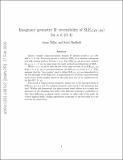Imaginary geometry II: Reversibility of SLE[subscript κ](ρ[subscript 1];ρ[subscript 2]) for κ ∈ (0,4)
Author(s)
Miller, Jason; Sheffield, Scott Roger
DownloadSheffield_Imaginary Geometry II.pdf (921.5Kb)
OPEN_ACCESS_POLICY
Open Access Policy
Creative Commons Attribution-Noncommercial-Share Alike
Alternative title
Imaginary geometry II: Reversibility of SLEκ (ρ1;ρ2) for κ ∈ (0,4)
Terms of use
Metadata
Show full item recordAbstract
Given a simply connected planar domain D, distinct points x,y ∈ ∂D, and κ>0, the Schramm–Loewner evolution SLE[subscript κ] is a random continuous non-self-crossing path in [bar over D] from x to y. The SLE[subscript κ](ρ[subscript 1];ρ[subscript 2]) processes, defined for ρ[subscript 1],ρ[subscript 2] > −2, are in some sense the most natural generalizations of SLE[subscript κ].
When κ≤4, we prove that the law of the time-reversal of an SLE[subscript κ](ρ[subscript 1];ρ[subscript 2]) from x to y is, up to parameterization, an SLE[subscript κ](ρ[subscript 2];ρ[subscript 1])from y to x. This assumes that the “force points” used to define SLE[subscript κ](ρ[subscript 1];ρ[subscript 2]) are immediately to the left and right of the SLE seed. A generalization to arbitrary (and arbitrarily many) force points applies whenever the path does not (or is conditioned not to) hit ∂D∖{x,y}.
The proof of time-reversal symmetry makes use of the interpretation of SLE[subscript κ](ρ[subscript 1];ρ[subscript 2]) as a ray of a random geometry associated to the Gaussian-free field. Within this framework, the time-reversal result allows us to couple two instances of the Gaussian-free field (with different boundary conditions) so that their difference is almost surely constant on either side of the path. In a fairly general sense, adding appropriate constants to the two sides of a ray reverses its orientation.
Date issued
2016-05Department
Massachusetts Institute of Technology. Department of MathematicsJournal
The Annals of Probability
Publisher
Institute of Mathematical Statistics
Citation
Miller, Jason, and Scott Sheffield. “Imaginary Geometry II: Reversibility of SLE [subscript κ] (ρ[subscript 1];ρ[subscript 2] for κ ∈ (0,4).” The Annals of Probability 44.3 (2016): 1647–1722.
Version: Author's final manuscript
ISSN
0091-1798